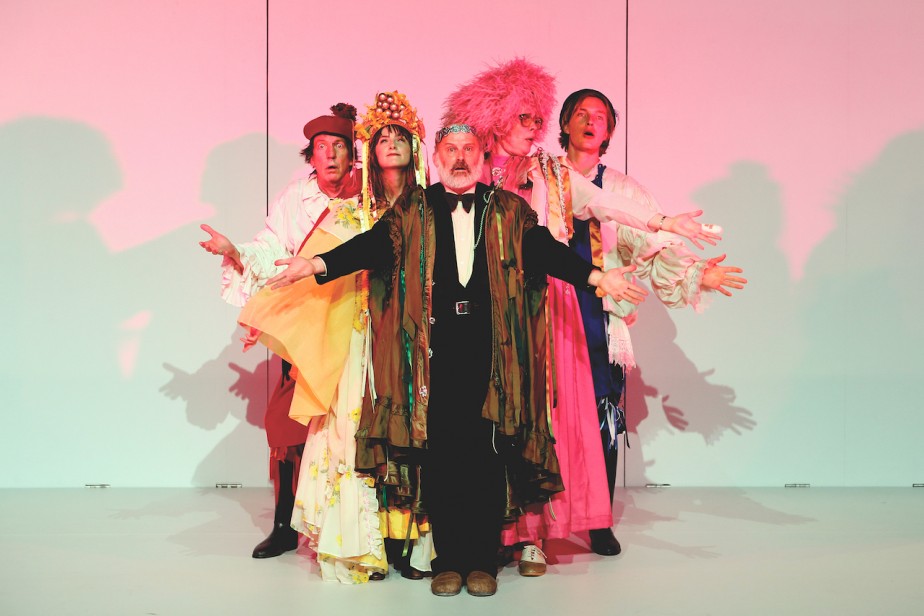
Robert Menzies, Esther Hannaford, Glenn Hazeldine, Katherine Tonkin and Sean Keenan. Photo: Jeff Busby
Set in 1971 in a psychiatric facility, Così is a play about friendship, romance, community and difference. At its heart is a group of people at odds with society: the inmates of an asylum. Enter Lewis (Sean Keenan), fresh out of uni and keen to help the resident patients trial a new kind of therapy – putting on a play (a much bigger challenge than he ever anticipated). Lewis and his friends are also at odds with much of society: they are actively involved in protesting Australia’s involvement in the Vietnam War. They’re also into feminism and free love – two more red flags, especially 50 years ago.
The second of a trilogy of semi-autobiographical plays, Così premiered in 1992 at Belvoir St Theatre, became a film in 1996 (shot in and around Rozelle’s Callan Park, originally called Callan Park Hospital for the Insane), and since then has become an Australian classic and a fixture on school curriculums. Despite its Vietnam context and its ’70s attitudes, it stands the test of time because ultimately it’s about love and community and trying to understand one another. Give it another few years and we can call it a period piece.
This Così, a Sydney Theatre Company collaboration with Melbourne Theatre Company, has already had a season in Victoria and is well bedded in. Under Sarah Goodes’ direction it is tightly paced and quite glorious. It begins in darkness – literally – with Lewis, his girlfriend Lucy (Esther Hannaford) and their supremely confident best mate Nick (Gabriel Fancourt) trying to find the light switch inside the psychiatric facility’s pitch-black and damaged theatre space. It ends in bursts of colour and light. First though, Lewis has to find a way to make the show go on.
His first lesson is to listen to Justin (George Zhao), the patronising social officer held in derision by the would-be thespians, who explains to him that he “just has to make it interesting… get them out of their shells”. Lewis’s next lessons are more instructive: how to find a way through the minefield he has undertaken, effect compromises, listen to the woes of his cast – and in doing so understand their backstories and what has brought them to a place of asylum – and get to opening night.
Roy (Robert Menzies) sees himself as the leader of this troupe of actors and is determined that they will perform Mozart’s Cosi Fan Tutte. Lewis suggests a play but Roy is not going for some minor Brechtian nonsense: it’s Cosi Fan Tutte or nothing. Never mind that no one can sing, let alone sing opera, or speak Italian. Or, for that matter that Zac, the allocated pianist (also played by Fancourt), is more or less perpetually zonked out on lithium, and prefers Wagner
And so begins a rollercoaster of comedy, pathos and mayhem – much like the rehearsals for any play, you might think, but when there’s a full blown arsonist in the cast, and a woman with psychotic tendencies, and others who are skipping their medication, well the mayhem is on a much higher level than normal.
Dale Ferguson’s set is suitably shabby, all ‘burnt wood and mould’, with lots of doors to add to the farce-like humour and, unlike the gloomy interior, the outside world glimpsed through those doors is always super bright (thanks to Lighting Designer Niklas Pajanti).
The ’70s vibe comes through loud and clear. Costume Designer Jonathon Oxlade reminds us of a time of polyester shirts, high rollneck sweaters, corduroys and flares, and in Act 2 gives us a kaleidoscope of pinks, oranges, blues and pastels for the performance of Cosi Fan Tutte itself (as adapted, with little music and some interesting props).
Robert Menzies shines as Roy, who is chasing a long-cherished dream to take to the boards..For Roy, the play’s the thing, his escape into freedom and adulation, something to fill the aching sadness and depression he has felt since he was orphaned as a child. Menzies plays him to the hilt, from a Noel Coward-like pomposity to what could be Oscar Wildean despair. It’s a fabulous performance.
As Cherry, Bessie Holland has her own delusions of grandeur, laced with a fair degree of menace, and she is going to fight for her moment of theatrical fame – and for a chance to smooch the director. She’s a figure of fun, but she’s not going to sit down be told what women can and cannot do, so Mozart – and Cosi Fan Tutte – be damned.
As the sex-obsessed pyromaniac with a tendency to burn cats, Doug (Rahel Romahn) is at once sleazy, hilarious and dangerous, although his uncontrolled urge to set fire to things puts a huge dampener on his thespian prospects. He finds this unjust of course.
Ruth (Katherine Tonkin) is tortured by life – is it real? is it an illusion? – and takes refuge in doing everything by numbers, literally. But Justin’s stated belief that doing a play could really bring the patients out of their shells ultimately works for her. There are no stars in this amateur show, but Ruth opens her heart a little and blossoms in her own way.
Glenn Hazeldine’s Henry is a bit of a scene stealer. Almost mute with rage and embarrassment, it takes a while for him to come out of himself, but when he does emerge to share a little history and divulge his tortured personality, it’s both tragic and comic.
Lastly, there is Julie (also played Hannaford), the most stable of the inmates, addicted to heroin and wishing no other remedy other than to get out, and score.
The counterpoint to all this is Lewis’s own life, and his relationship with his ultra-Leftie mates Lucy and Nick. Female fidelity, as ridiculed by some of the cast of Cosi Fan Tutte, is challenged by the attitudes towards free love in Lewis’s life, and a totally inappropriate attraction between himself and Julie.
The denouement between Lucy and Lewis is the clunkiest part of Così, but it’s not the bigger picture. Così is all about working on something transformative, something that could change lives and, even if it doesn’t, can still bring much joy. This play within a play is a wonderful piece of theatre, something to make your spirit soar.
Until 14 December.
Tickets from $50 (under 30) to $103, plus booking $8.50 booking fee



